
|
While an award-winning chair may look beautiful, can it really represent the pinnacle of mankind's genius if it is made using polluting methods or by exploiting workers?
Small numbers of new products are becoming available that have a 'total beauty' about them - their total life history, from the cradle of raw materials production to their end of life has been designed to minimise environmental and social impact.
|
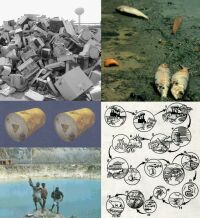
|
Hidden Ugliness
An individual product may look harmless enough. But the environmental damage it causes happens elsewhere, out of sight and mind, "hidden" from the consumer and often from the designer as well.
Pollution, deforestation, species loss, and global warming are all by-products of manufacture. I call this the "Hidden Ugliness" of products.
|

|
Total Beauty
It's no longer enough that a product is pretty on the outside, cheap and available. We owe it to the coming generations who will have to clean up our products in the future to manufacture in harmony with nature.
We have to reveal all these hidden environmental and social impacts and create products that have a "total beauty". These products, also known as 'sustainable products', are those that are the best for people, profits and the planet.
|
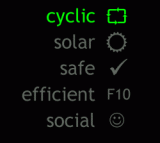
|
Cyclic
By recycling more minerals we can mimick nature.
And obviously, using materials that have been grown is also a good thing -- there are now plastics made from corn as well as the classic natural materials like wood and paper and leather to choose from.
The product is made from compostable organic materials or from minerals that are continuously recycled in a closed loop
|
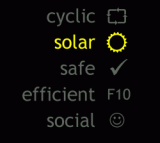
|
Solar
All materials flow can be powered by photosynthesis, muscle or renewable energy. This covers products with mounted photovoltaic solar cells, or those hooked up to a mains supply powered by wind, wave, biomass, or PV, through to products that are grown or operated by hand. This also applies to 'embodied energy' - the energy used to manufacture and distribute a product.
The product in manufacture and use consumes only renewable energy that is cyclic and safe
|
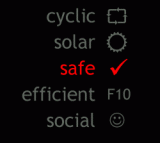
|
Safe
To be compatible with nature, we need to eliminate releases of materials that disrupt life. This obviously includes liquid effluent from pipes, smoke from chimneys, and spills onto the ground. However, as all products are ultimately disposable, it also includes products themselves. If there is no plan or system for product takeback and full reuse and cyclicity, then every product sold represents a toxic release.
All releases to air, water, land or space are food for other systems
|
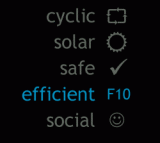
|
Efficient
Despite materials and energy often appearing to be cheap, it still makes commercial and logical sense to use them wisely.Less energy means less power station pollution, less metal means less mining, and so on.
"Tomorrow will be Less" - Philippe Starck
The product in manufacture and use requires 90% less materials, energy and water than products providing equivalent utility did in 1990
|
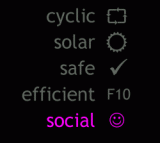
|
Social
Exploitation and maltreatment of our fellow man is unsupportable, yet companies do it all the time because such abuse is hidden to the end user. Do we deliberately design our products so that they involve child labour and unsafe working conditions? Of course not. But unless we use our influence to actively design these problems out, they will still be there.
Product manufacture and use supports basic human rights and natural justice
|
The Eleven Principles of Total Beauty
When you've been looking at sustainable products for a while, you notice that the same solutions come up time and again. Based on a review of 500 products, I found that 99% of all environmental innovations use one of more of these eleven principles:
|
1 Cyclic Mineral
2 Cyclic Grown
3 Alternative Energy in Use
4 Alternative Energy in Manufacture
5 Substitute Materials
6 Stewardship Sourcing
7 Utility
8 Durability
9 Efficiency
10 "Bio-everything"
11 Communication
|
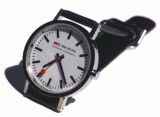
|
1 Cyclic Mineral (CYM)
The product becomes more cyclic by making use of recycled metal, glass or plastic, by becoming more recyclable, or both.
This case of this watch by Mondaine is made of 100% post-consumer recycled brass.
|
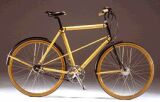
|
2 Cyclic Grown (CYG)
The product becomes more cyclic by making use of grown materials such as wood, leather and wool, or by becoming more compostable, or both.
This bicycle is made for Hermès from rattan and bamboo.
|
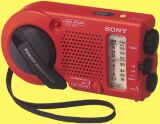
|
3 Alternative Energy in Use (AEU)
The product becomes more solar by using a renewable energy in use, sometimes by using solar-generated electricity.
The Sony ICF-B200 uses muscle power, a form of solar energy, to wind the dynamo that recharges the internal battery.
|

|
4 Alternative Energy in Manufacture and Distribution (AEM)
The product becomes more solar by using a renewable energy source for its manufacturing process.
Urtekram's personal care products and food factory in Denmark is powered by hay and wind.
|

|
5 Substitute Materials (SUB)
The product becomes safer as a result of toxic materials or components being substituted for safer ones.
Climatex Lifecycle is an organic wool and ramie fabric that is compostable and non toxic. Over 8000 dyes and finishes were tested, and only 38 were found to be totally safe. From these, Climatex's textile mill Rohner was able to make any colour fabric.
|

|
6 Stewardship Sourcing (STW)
The product helps preserve habitats, or also is more social, by getting raw materials from fairly-traded sources or low impact sources such as FSC approved forests.
These shoes from Deep E Co. are made from organically grown leather and natural rubber that was tapped from wild trees and fairly traded.
|

|
7 Utility (UTY)
The product becomes more efficient by providing greater utility for the user, such as multifunction products or rented products.
The Tripp Trapp Chair can be adjusted to seat a person throughout their childhood, and so is a baby chair, child chair and teen chair all in one.
|

|
8 Durability (DUR)
The product becomes more efficient in materials usage as it lasts longer.
The Spacepen Millennium II contains a lifetime's worth of ink.
|
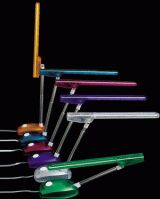
|
9 Efficiency (EFF)
The product becomes more efficient in its use of energy, water and materials, both in manufacture and use.
The e.light uses 90% less energy than standard desk lamps - only 3 Watts.
|

|
10 "Bio-everything" (BIO)
The product becomes more cyclic, solar and safe as a result of using living organisms or biomimcry techniques.
FoxFibre is organically-grown cotton that has been bred from naturally coloured, wild varieties, so eliminating the need for dyes.
|
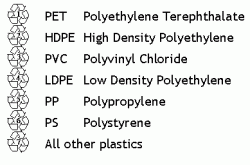
|
11 Communication (COM)
The product communicates information that leads to a better environmental performance, usually by changing the behaviour of users.
Plastics labelling helps recycling and uses numbers from 1 to 7.
|
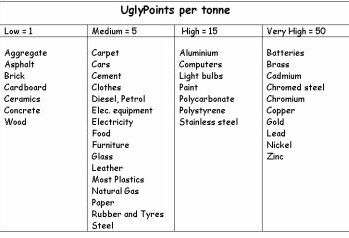
|
Materials Impacts
I have given each type of material an UglyPoints score that shows its impact per tonne.
|

|
Product Scoring
It's also possible to give a product a score out of 4 on
each of the cylic, solar and safe factors. This is the score for the e.light.
|
|
|
You are a Revolutionary
Back in the studio tomorrow, your colleagues may not be quite up to speed on all this. It is inevitable that you will face confusion and downright hostility. Be gentle with them.
30% of your colleagues will look on your point of view favourably, but they will not support you openly, at least not at the beginning. This is because they think that they are alone in their beliefs and because environment and sustainability are not culturally accepted as being important. An experiment at a shipping firm had a team of managers each write down anonymously what they thought of the environment, and what they thought their colleagues thought. Every manager had put down, "I think the environment is important, but no-one else does."!
|
Here are the top ten tips for being an environmental design change agent:
1. Do what counts and do what works. Get on with it and prioritise which areas have the most impact on the environment and which have the most scope for improvement.
2. Exert influence on those who need it. It's so easy to spend time with your supporters, when it is usually the grumpy people in accounts or marketing that need to be brought on board.
|
3. Use feedback to create a virtuous cycle of improvement. It's also vital to make the invisible visible, as so often environmental problems are out of sight and out of mind.
4. Persist. It's a long slog and you need patience and tenacity.
5. Repeat, repeat and repeat. Ideas sink in deeply only after repetition, and you have to fight for your client's and colleagues' mindshare.
|
The rest of the top ten tips for being an environmental design change agent:
6. Remember it is easier to ask for forgiveness than for permission. Just do it before anyone notices.
7. Ask good questions. Especially "why not?".
8. Be a model of what you want people to do. Obviously you must walk your total beauty talk. But don't get too far ahead of your constituency.
|
9. Personalize your points. Tell them why what you're saying is important to them - 'What's in it for Me?'
10. Remember, if you don't ask, it will NEVER happen. As the famous sports saying goes, "you miss one hundred percent of the shots you don't take."
|

|
Becoming 100% sustainable is not only possible, it can be achieved by the year 2100. By moving away from the "how can we be less bad?" mentality to the "how can we be 100% good?" mindset, we give ourselves the capability of redesigning every product to be 100% cyclic, solar and safe.
One day, all products will be like this. Make today be the first step towards that day.
|
|